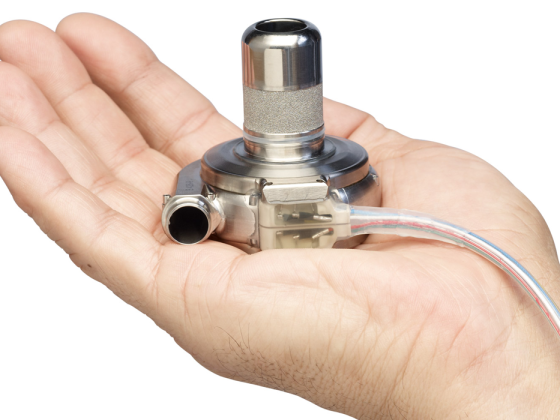The 7th Iron Academy in Zurich was all about iron deficiency. This occurs with or without anemia, at any age and in very different situations. In chronic diseases such as renal failure, high-normal ferritin levels are targeted to compensate for the blocked release of iron from the body’s stores.
(rs) First, we addressed iron deficiency in the pediatric patient. In the last trimester of pregnancy, fetuses absorb about two-thirds of the required amount of iron. While a healthy term-born child has sufficient iron reserves for 1-6 months and is initially supplied with sufficient iron through breast milk, which is a moderate source of iron, the amount supplied is insufficient in premature infants. “All infants born before term are at increased risk for iron deficiency anemia and should receive peroral iron supplementation,” said PD Markus Schmugge, MD, chief hematologist at Zurich Children’s Hospital, at the 7th Iron Academy in Zurich.
In addition, risk groups for iron deficiency anemia include infants who were born on schedule but have low birth weight and infants who are exclusively breastfed for a period of six months. The reason for this is that the iron content of breast milk decreases dramatically after five months. In advanced childhood, disabled children as well as children from socially deprived families and post-menarche girls belong to the risk group for iron deficiency anemia due to their often difficult feeding behavior. In children without clinical signs of iron deficiency and without anemia, a cautious approach is indicated: “In these cases, counseling the mothers is often sufficient,” says Dr. Schmugge.
Key dietary tips include reducing cow’s milk consumption for improved enteral iron absorption or introducing key iron sources such as formula milk or gruel in mothers breastfeeding for longer than six months. The indication for peroral iron supplementation is when there is an increased risk or symptoms of iron deficiency and always in the presence of iron deficiency anemia; it is also important here to observe age-appropriate hemoglobin and hematocrit normal values. Peroral iron preparations differ in that divalent iron is better absorbed but is more likely to cause gastrointestinal side effects. Trivalent iron is characterized by a better taste and better tolerance, but it requires a higher dosage and double to triple the treatment time. For Hb values below 7.5 g/dL, parenteral iron substitution should be discussed. It remains unclear whether a neurocognitive developmental disorder caused as a consequence of prolonged iron deficiency can be improved by iron correction.
Iron deficiency in postpartum women
Iron deficiency anemia during pregnancy can have significant health consequences for both mother and child. These range from fetal growth retardation and prematurity to increased risk of maternal and infant mortality. To assess the risk of iron deficiency, the Swiss Society of Gynecology routinely recommends checking serum ferritin at the beginning of pregnancy. To exclude normal or falsely high ferritin values, CRP should be checked in addition. “Ferritin levels <30 μg/l indicate empty iron stores and require treatment,” explained Prof. Irene Hösli, M.D., chief physician at the Department of Obstetrics and Pregnancy Medicine at Basel University Hospital. This is true even if the Hb thresholds for anemia have not yet been reached: 10.5 g/dL in the second trimester and 11 g/L in the third trimester.
Decreased blood reserves in pregnant women are also problematic because the risk of severe postpartum hemorrhage has increased significantly with changing risk factors such as older age of pregnant women, increasing multiple pregnancies, and more frequent cesarean sections. Because the acute phase protein ferritin is often elevated in the puerperium and of limited significance, the indication for iron supplementation is based on Hb levels. In cases of mild anemia (Hb 9.5 to <10 g/dL), oral iron substitution (80-200 mg) is recommended; parenteral iron administration is also recommended in cases of poor tolerance or insufficient response. It should be noted here that substitution with iron carboxymaltose (Ferritin®) is only permitted from the second trimester onwards. In severe anemia (Hb <8.5 g/dL), i.v. iron administration (1000 mg) is started directly in the puerperium. For Hb values of <6 g/dL, immediate treatment with blood transfusion is indicated.
Iron deficiency in patients with renal insufficiency
Minimal anemia workup in chronic kidney disease (CKD) includes blood count with indices, serum ferritin, transferrin saturation, and CRP. Regardless of renal function, monitoring is performed annually or, depending on CKD stage, once (stage III), or two to three times per year (stage IV-V). “Absolute iron deficiency in CKD is rare in itself,” said Prof. Michael Dickenmann, MD, deputy head of the Department of Transplantation Immunology and Nephrology at University Hospital Basel. However, the elevated hepcidin levels that occur in CKD result in the blockage of iron mobilization from iron stores. “The only solution to get around this problem is to offer more iron to those affected,” Prof. Dickenmann explained. Relative iron deficiency is present when serum ferritin is less than 200 μg/l and/or transferrin saturation is less than 30%. The treatment of choice for relative iron deficiency in CKD is parenteral iron supplementation. “With oral iron supplementation, the target levels are difficult to achieve,” the specialist said. An indication for erythropoietin exists when iron stores are full (>200 μg/l) and Hb is below 11 g/dl. Administration of erythropoietin is contraindicated if iron stores are not adequately filled. After erythropoietin administration, Hb should be monitored at approximately three-month intervals. Correction of Hb to target values between 11-12.5 g/dL has been shown in studies to increase performance tolerance and reduce hospitalization frequency. Hb values of more than 13 g/dL, on the other hand, should be avoided, as the risk of thromboembolic complications increases significantly above this value.
One appeal that Prof. Dickenmann made to the symposium guests concerned the administration of blood transfusions. Administration of blood transfusions in CKD may make kidney transplantation impossible for years. CKD sufferers scheduled for kidney transplantation should therefore receive blood only in life-threatening situations.
Iron deficiency in patients with heart failure
The risk of iron deficiency anemia is multifactorial in chronic heart failure (CHF) and is particularly favored by diffuse inflammation and concomitant renal insufficiency. In addition to cardiac limitation and muscular deconditioning of heart failure patients, iron deficiency contributes to an increase in CHF symptoms and decreased performance.
Based on the results of a randomized placebo-controlled trial in heart failure patients (NYHA II-III) with iron deficiency with and without anemia, whose performance was significantly improved after parenteral iron supplementation, iron correction is also mentioned for the first time in the ESC guidelines for CHF treatment [1]. Correction is recommended for iron utilization disorders in CHF, especially in the presence of anemia (Hb values for women <12 g/dL and for men <13 g/dL). Iron deficiency is present with ferritin levels below 100 μg/l and reduced transferrin saturation. A “functional iron deficiency” exists when ferritin levels are below 300 μg/l and transferrin saturation is less than 20%. Before iron substitution, blood loss, for example, due to gastrointestinal bleeding, must be excluded. Total iron requirements can be calculated using the Ganzoni formula. “Because of the intestinal absorption disorder, substitution should be parenteral and preferably in small doses (e.g., 200 mg weekly until Hb value 16 g/dL),” said PD Matthias Wilhelm, MD, senior physician in the Department of Cardiovascular Prevention, Rehabilitation and Sports Medicine at Inselspital Bern.
Source:7th Iron Academy, March 27, 2014, Zurich
Literature:
- Anker SD, et al: Ferric carboxymaltose in patients with heart failure and iron deficiency. N Engl J Med 2009; 361: 2436-2448.
CARDIOVASC 2014; 13(3): 22-23











